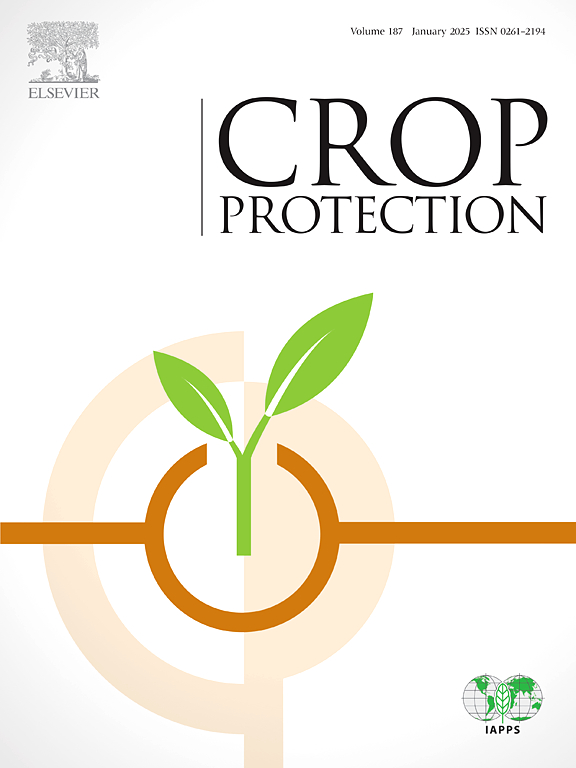Management of Helicoverpa armigera via plant-mediated RNA interference, progresses and challenges
IF 2.5
2区 农林科学
Q1 AGRONOMY
引用次数: 0
Abstract
Cotton bollworm Helicoverpa armigera (Hübner) (Lepidoptera Noctuidae) is a major agricultural pest that causes significant yield losses of crop plants each year. In the past few decades, the potent approaches of H. armigera control, including chemical insecticides and Bacillus thuringiensis (Bt) toxins, have been constrained due to health hazards, environmental contamination, and development of resistance, after their extensive application. Thus, there is need to find alternative strategies for H. armigera management. Expression of insect-targeted RNA interference (RNAi) constructs in host plants has emerged as one of such a novel and environment friendly strategies. However, various factors, such as highly active nucleases and high pH in the midgut, as well as failure of small interfering RNA to escape the endosome, lead to relatively low RNAi efficiency in lepidopteran insects. Although most plant-mediated RNAi experiments compromised insect development and growth of H. armigera, full protection of transgenic plants against H. armigera was not achieved and no commercially available product has yet been developed for H. armigera control. A clear understanding of the current status of RNAi utilization in H. armigera control is critical for improving its efficiency. In this review, we summarize the recent advances in plant-mediated RNAi for H. armigera control, including target gene selection, double stranded RNA or artificial microRNA expression from nuclear or plastid genome, and protection of RNAi molecules from degradation by nucleases. Additionally, we highlight factors influencing the efficacy of plant-mediated RNAi, and discuss the future research of this plant genetic engineering strategy for achieving effective management of H. armigera.

植物介导的RNA干扰对棉铃虫的管理、进展和挑战
棉铃虫(Helicoverpa armigera, h bner)(鳞翅目夜蛾科)是一种主要的农业害虫,每年给农作物造成严重的产量损失。在过去的几十年里,包括化学杀虫剂和苏云金芽孢杆菌(Bt)毒素在内的有效方法在广泛应用后,由于健康危害、环境污染和耐药性的发展而受到限制。因此,有必要寻找替代策略来管理棉铃虫。昆虫靶向RNA干扰(RNAi)构建体在寄主植物中的表达已成为一种新颖且环境友好的策略。然而,鳞翅目昆虫的RNAi效率相对较低,主要是由于中肠中核酸酶活性高、pH值高,以及小干扰RNA无法逃离内体等因素。虽然大多数植物介导的RNAi实验损害了昆虫的发育和生长,但转基因植物对棉铃虫的完全保护并没有实现,目前还没有商业化的产品用于控制棉铃虫。清楚了解RNAi在棉铃虫防治中的应用现状是提高其应用效率的关键。本文综述了植物介导RNAi防治棉铃虫的研究进展,包括靶基因的选择、核或质体基因组双链RNA或人工microRNA的表达、RNAi分子不被核酸酶降解的保护等。此外,我们强调了影响植物介导的RNAi效能的因素,并讨论了该植物基因工程策略的未来研究,以实现对棉蚜的有效管理。
本文章由计算机程序翻译,如有差异,请以英文原文为准。
求助全文
约1分钟内获得全文
求助全文
来源期刊

Crop Protection
农林科学-农艺学
CiteScore
6.10
自引率
3.60%
发文量
200
审稿时长
29 days
期刊介绍:
The Editors of Crop Protection especially welcome papers describing an interdisciplinary approach showing how different control strategies can be integrated into practical pest management programs, covering high and low input agricultural systems worldwide. Crop Protection particularly emphasizes the practical aspects of control in the field and for protected crops, and includes work which may lead in the near future to more effective control. The journal does not duplicate the many existing excellent biological science journals, which deal mainly with the more fundamental aspects of plant pathology, applied zoology and weed science. Crop Protection covers all practical aspects of pest, disease and weed control, including the following topics:
-Abiotic damage-
Agronomic control methods-
Assessment of pest and disease damage-
Molecular methods for the detection and assessment of pests and diseases-
Biological control-
Biorational pesticides-
Control of animal pests of world crops-
Control of diseases of crop plants caused by microorganisms-
Control of weeds and integrated management-
Economic considerations-
Effects of plant growth regulators-
Environmental benefits of reduced pesticide use-
Environmental effects of pesticides-
Epidemiology of pests and diseases in relation to control-
GM Crops, and genetic engineering applications-
Importance and control of postharvest crop losses-
Integrated control-
Interrelationships and compatibility among different control strategies-
Invasive species as they relate to implications for crop protection-
Pesticide application methods-
Pest management-
Phytobiomes for pest and disease control-
Resistance management-
Sampling and monitoring schemes for diseases, nematodes, pests and weeds.
 求助内容:
求助内容: 应助结果提醒方式:
应助结果提醒方式:


